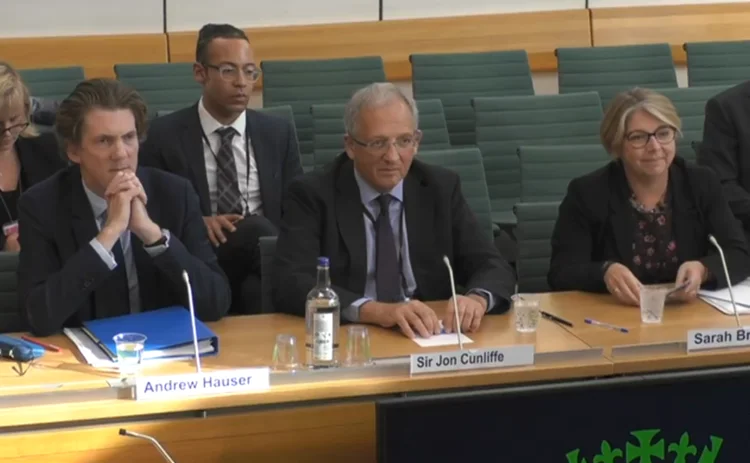
Gilts debacle exposes financial stability risks
Lurking leverage in liability-driven UK pension investments raises important questions for central bankers
The Bank of England was forced to provide emergency support to the UK sovereign bond (gilts) market in September, following a misjudged ‘mini-budget’ promising tens of billions of pounds of unfunded tax cuts by the then government of Liz Truss.
The UK administration’s budget spooked investors, sparking a sell-off of UK gilts, whose yields spiked up to 5%. To address contagion risks from a gilts sell-off by UK pension funds that had pursued leveraged, liability-driven investment (LDI) strategies, the BoE committed on September 28 to buy up to £65 billion of sovereign bonds during a two-week window. Its intervention was combined with forceful communication to prevent further market contagion, with the measures ultimately proving to be successful.
The emergency action put the BoE in an awkward position, however. On the one hand, it was buying government bonds; while on the other, trying to offload them from its balance sheet as part of its ‘quantitative tightening’ (QT). QT, alongside interest rate rises, is an integral part of the central bank’s monetary policy effort designed to control double-digit inflation. Effectively managing these sorts of monetary policy versus financial stability policy conflicts looks to be a significant challenge for central banks moving forwards.
My message to the funds involved and all the firms involved managing those funds… You’ve got three days left now. You’ve got to get this done
Andrew Bailey, Bank of England
Indeed, the debacle highlights several other important issues. Government debt in the UK and many other countries is now at precarious levels. Overall global debt (private and government) already stood at 256% of GDP in 2020 versus 195% in 2007, according to IMF statistics. Advanced nations and China accounted for the largest rises, and public debt accounted for almost 40% of the global total, its highest share since the mid-1960s. This means governments and central banks have much more limited policy room and are exposed to potentially negative 'nonlinear' consequences when they make mistakes (Central Bank of Armenia governor Martin Galstyan explains how monetary policy frameworks could potentially be set up to try to avoid such outcomes). The Financial Stability Board warned in its latest annual report that “debt-servicing pressures may surface across the sovereign, non-financial corporate and household sectors”.
The ability for central banks to operate independently to pursue their mandated roles is still important – likely more so in a high-debt, low-growth inflationary world. While the BoE may have been slow to react to the threat of entrenched inflation – and there are many ‘whole-of government’ central banks that function just as well as operationally independent ones (typically when there is an effective government) – it moved swiftly to address the UK gilt liquidity squeeze, by intervening in a timely manner and in sufficient scale, operating independently of government. Indeed, the perceived threat to the authority of the BoE, and that of the Office for Budget Responsibility, which was set up to examine the sustainability of UK public finances, with neither sounded out prior to the 'mini-budget', were contributing factors to the initial gilts sell off.
Credible communication is critical. The BoE faced a tricky balancing act when it, once more, became a ‘liquidity provider of last resort’. It needed to explain that the move would be effective but would only be in place for a specified time period, in a bid to limit moral hazard. It was also important to communicate that the intervention would not undermine the central bank’s own monetary policy – while at the same time trying not to damage its relations with the government.
The BoE’s officers quickly secured a government indemnity for their actions and ratcheted up communications with market participants to reinforce that its support window had a strict time limit. This proved to be particularly challenging following a Financial Times report that claimed the BoE planned to extend its 13-day window. “My message to the funds involved and all the firms involved managing those funds,” BoE governor Andrew Bailey told a panel in Washington, DC, on October 11: “You’ve got three days left now. You’ve got to get this done.” Bailey’s strong, ‘off the cuff’ comments, along with forceful communications by the BoE team to UK pension funds about their need to build up capital or deleverage quickly, appeared to do the trick.

We could never rule out doing asset purchases again, they are very powerful, but I am hopeful there are better ways to do it
Andrew Hauser, Bank of England
The structure of the BoE’s actions was also important. A key design feature for the intervention was its ‘reverse auction’ format. Instead of buying fixed quantities of bonds at any price, as occurred during quantitative easing, the BoE’s auction meant the central bank would reject any bids it deemed uncompetitive. The aim was to remove the liquidity premium implied in gilt yields but avoid influencing market prices any further. Despite stating its ability to purchase up to £65 billion ($72.3 billion) of gilts over 13 days of interventions, it ultimately only acquired around £19 billion. The BoE has now started to reduce its ‘financial stability gilt portfolio’ via a reverse enquiry window, where, once more, only competitively priced bids will be accepted.
Central banks have learned from the ‘dash for cash’ episode in the US Treasury markets in March 2020 and are better prepared for their emerging role as ‘market-makers of last resort’ – although not fully. The Bank of England regularly speaks with market participants to assess potential sources of market risk – and it is now stepping up communication with pension funds and their regulators (it has no oversight in this area). The Basel-based Markets Committee had also produced preliminary analysis on market backstops, which guided the BoE’s September intervention. However, the BoE’s executive director for markets, Andrew Hauser, said the UK central bank failed in its efforts to use a repo liquidity management tool, which would have safeguarded the central bank’s balance sheet, as pension funds needed to “deleverage, not re-leverage”, as they didn’t have available collateral to pledge. “I do think there’s a much bigger set of issues for central banks globally … about how you develop the toolkit, that repo-based toolkit, to deal with this non-bank situation in the future. We could never rule out doing asset purchases again, they are very powerful, but I am hopeful there are better ways to do it,” Hauser told UK lawmakers.
Not all financial stability risks are accounted for. Liability-driven investment approaches have gained prominence in the past couple of decades. The logic underpinning them is appealing: pension funds’ asset holdings should match up to their expected future liabilities. What has proven problematic is that schemes offered by asset managers (and signed off by asset consultants) include ‘hidden’ leverage by using collateralised margins to trade derivatives rather than the underlying asset. It was the derivatives margin calls that triggered forced sales by asset managers as risk was repriced and the FSB is seeking to address risks associated with 'hidden' leverage moving forwards. Some LDI managers (several of which have lobbied hard to avoid being viewed themselves as global systemically important financial institutions) also forced sales on pension funds. Overall, the BoE’s executive director for financial stability strategy and risk, Sarah Breeden, said pooled funds recognised the dangers, but some operating segregated accounts were “prevaricating”.
This all comes at a time when withdrawal from large-scale asset purchases may prove to be far more difficult to manage than buying the assets in the first place. Viral Acharya’s research presented at Jackson Hole found that while QE leaves the banking system with more on- and off-balance-sheet demandable claims, these are not simply reversed with QT, due to the development of what he terms ‘liquidity dependence’. The implication is that QE should be thought through carefully as liquidity risks rise significantly during periods of QT.
Overall, slowing economic growth, sharply higher interest rates and QT are raising significant financial stability risks. These risks, so far, appear to have materialised mostly outside of the highly regulated banking system (although they could rapidly feed through during a downturn). This is a particular concern given many of the tabled non-bank financial intermediary regulatory reforms have stalled.
Only users who have a paid subscription or are part of a corporate subscription are able to print or copy content.
To access these options, along with all other subscription benefits, please contact info@centralbanking.com or view our subscription options here: http://subscriptions.centralbanking.com/subscribe
You are currently unable to print this content. Please contact info@centralbanking.com to find out more.
You are currently unable to copy this content. Please contact info@centralbanking.com to find out more.
Copyright Infopro Digital Limited. All rights reserved.
As outlined in our terms and conditions, https://www.infopro-digital.com/terms-and-conditions/subscriptions/ (point 2.4), printing is limited to a single copy.
If you would like to purchase additional rights please email info@centralbanking.com
Copyright Infopro Digital Limited. All rights reserved.
You may share this content using our article tools. As outlined in our terms and conditions, https://www.infopro-digital.com/terms-and-conditions/subscriptions/ (clause 2.4), an Authorised User may only make one copy of the materials for their own personal use. You must also comply with the restrictions in clause 2.5.
If you would like to purchase additional rights please email info@centralbanking.com








